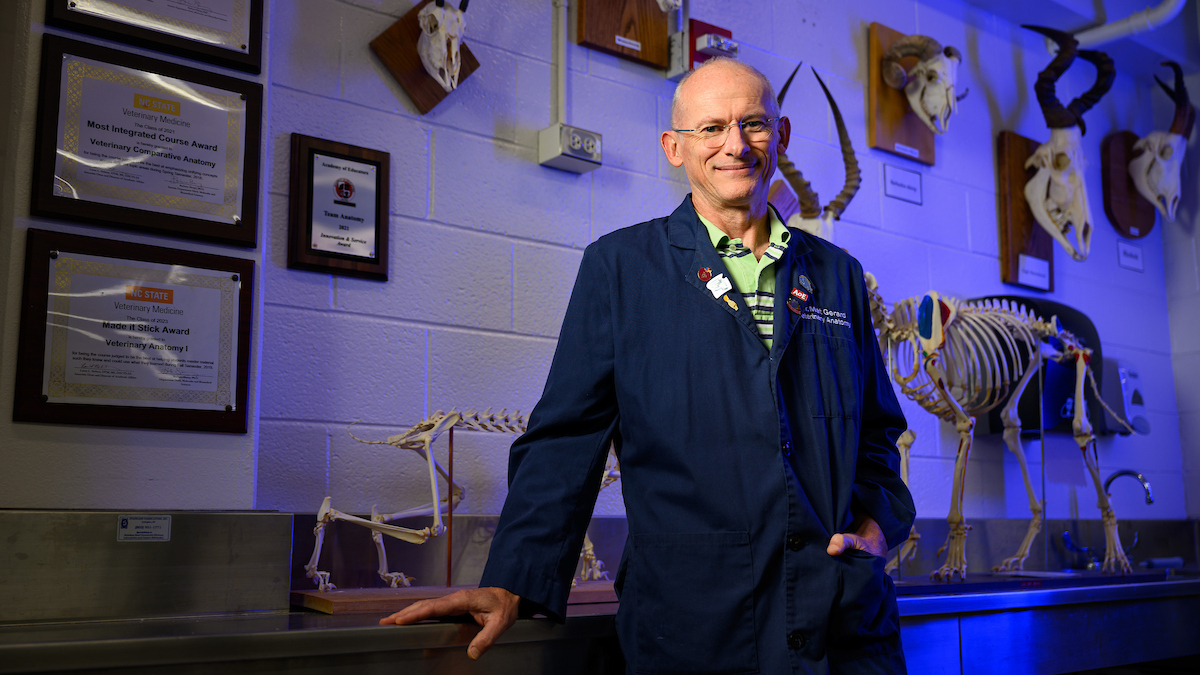Dogs May Hold Key to Fighting Human Bladder Cancer

A pioneering bladder cancer study launching at the NC State College of Veterinary Medicine will compare the origins and characteristics of the disease in dogs and humans, a promising approach to developing earlier diagnosis and improved therapies for both species.
The two-year project, which recently received funding from the V Foundation for Cancer Research, will explore the genetic similarities between canine bladder cancer and the closely representative human version of the disease. Researchers will also evaluate the cancer’s potential environmental causes in dogs who have naturally acquired the condition.
The data could provide insight into bladder cancer risk factors for humans, as researchers believe early canine bladder cancer is genetically similar to human high-risk, non-muscle invasive bladder cancer.
Matthew Breen, CVM professor of genomics and the Oscar J. Fletcher Distinguished Professor of Comparative Oncology Genetics, is co-directing the project with Heather Stapleton, associate professor of environmental chemistry and health at Duke University. Claire Wiley, a CVM clinician-investigator, internal medicine specialist and Ph.D. student in Breen’s lab, is overseeing the project’s day-to-day operations.
The research is reflective of the growing prominence of comparative oncology, using animal cancer research findings to study human cancer and develop effective treatments.
“We think that inclusion of high-quality data from our canine companions offers potential to accelerate discoveries toward improving cancer care in humans as well as dogs,” said Breen, a world-leading comparative oncology researcher.
The study will integrate genetic and mutational findings with environmental exposure data to eventually outline DNA sequence mutation profiles of dogs and humans with bladder cancer. Researchers hope to identify key genetic influences on the disease’s progression shared between the species.
Through analyzing silicone tags affixed to dog collars, the research team will also pinpoint several environmental exposures that have been proposed to be linked to bladder cancers, including chemicals in pesticides and water disinfection byproducts.
Canine bladder cancer has been traditionally thought of as a model for the aggressive human disease, muscle-invasive bladder cancer. This new study proposes that with earlier detection, canine bladder cancer shows similarities to human non-muscle invasive bladder cancer, the most commonly diagnosed type of the disease.
Bladder cancer is the 9th most common human cancer, and more than 60,000 dogs are diagnosed with bladder cancer each year.
While humans with non-muscle invasive bladder cancer have high life expectancy rates, more than half of patients experience tumor recurrences after therapy. Long-term therapies, including numerous surgeries, are often the norm. High-risk non-muscle invasive bladder cancer can progress to the aggressive muscle-invasive form, but there is no method to distinguish low-risk from high-risk. The canine disease may hold the key in identifying risk factors for the high-risk disease.
The study has received support from a large group of multidisciplinary clinicians and researchers at the CVM, the Comparative Urothelial Carcinoma Group research collective. Members of the group have received funding for other cancer projects from the Consortium for Canine Comparative Oncology or C3O, a collaboration between the CVM and the Duke Cancer Institute.
The research is a continuation of a pilot study launched earlier this year that integrated a new test, the CADET BRAF, developed by Breen at the CVM. It’s the world’s first non-invasive liquid biopsy to detect cancer in dogs.
Bladder cancer was the 9th most common human cancer diagnosed in the United States last year, causing 17,000 deaths. More than 60,000 dogs are diagnosed with bladder cancer each year in the U.S. The disease is particularly pernicious for dogs since it is often not detected as early as it is in humans.
Dog owners typically do not notice signs of the disease, such as blood in urine or strained urinating, until the tumor grows to a larger size and obstructs the urethra, said Wiley. By this time, an aggressive bladder tumor once the size of a grain of rice has grown to the size of a grape — and sometimes to the size of a golf ball. By then, it contains millions of cancer cells.
“The most heartbreaking thing about canine bladder cancer is that early clinical signs are hard to notice in dogs, so we’re already a step behind right off the bat,” said Wiley.
For Breen, the project’s in line with more than 20 years spent dedicated to comparative biomedical research, with a particular focus on the comparative aspects of canine cancer. He was a member of the team that decoded the canine genome in 2005. Since arriving at the CVM, his lab has conducted cancer research that addresses both dogs and humans, including investigations into numerous different cancer types.
“We are shifting the needle on cancer research,” said Breen. “Working closely with human cancer researchers, we are understanding more about the value that dogs bring to advancing our common goal of helping cancer patients, whether they have two legs or four.”
~Jordan Bartel/NC State Veterinary Medicine
This study is looking for owners of Scottish terriers, West Highland white terriers, Shetland sheepdogs, beagles, American Eskimo dogs, and Jack Russell/Parson terriers older than 6 years. For more information, go to https://go.ncsu.edu/utract-study


